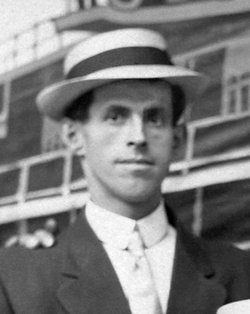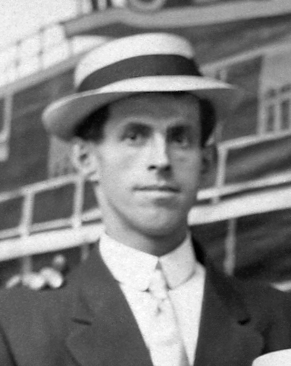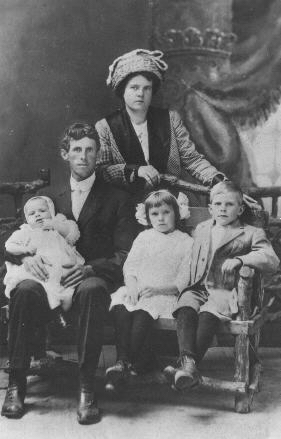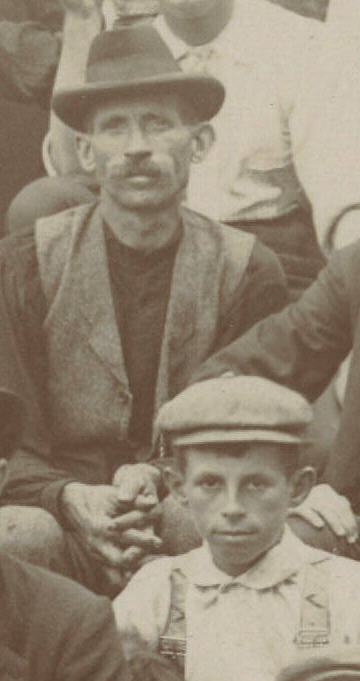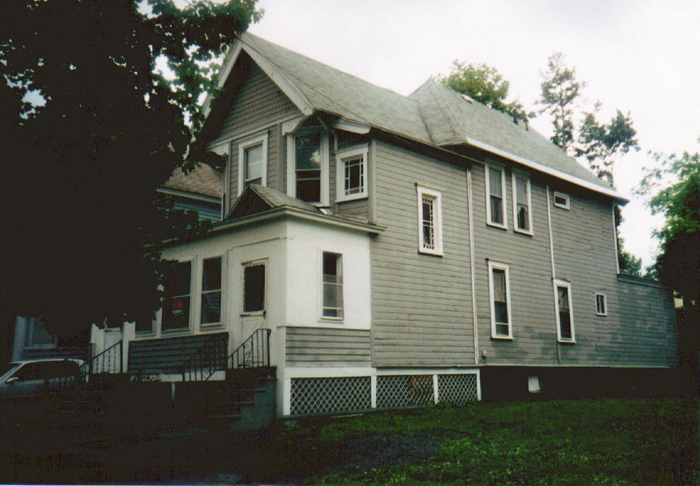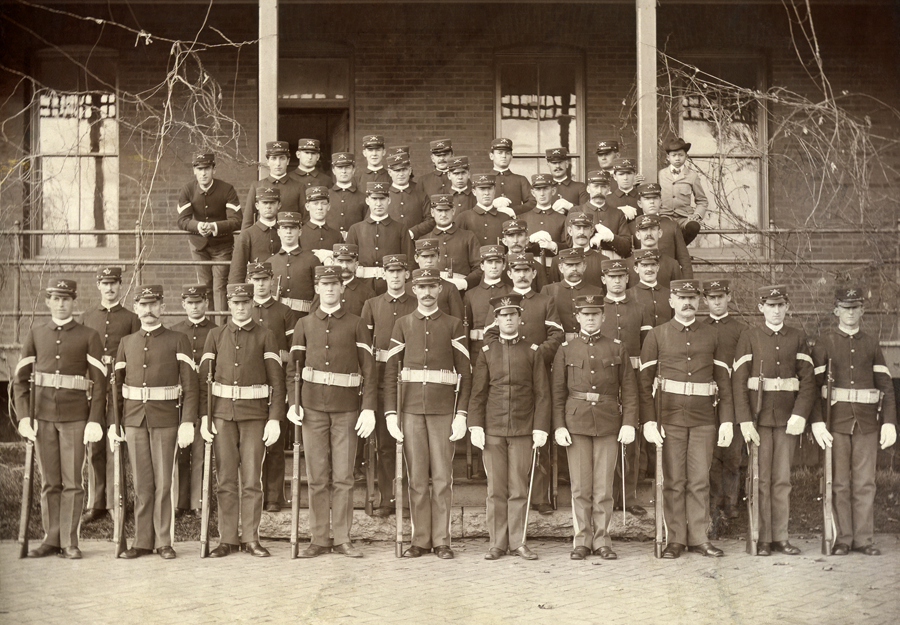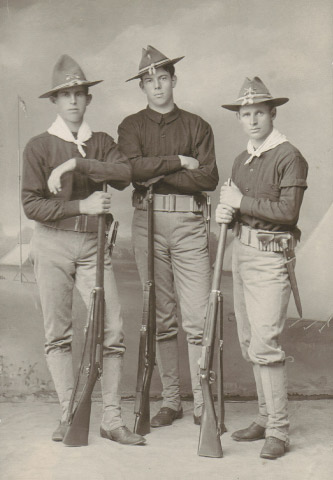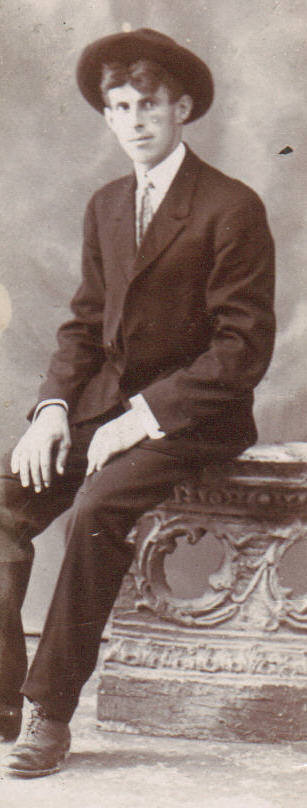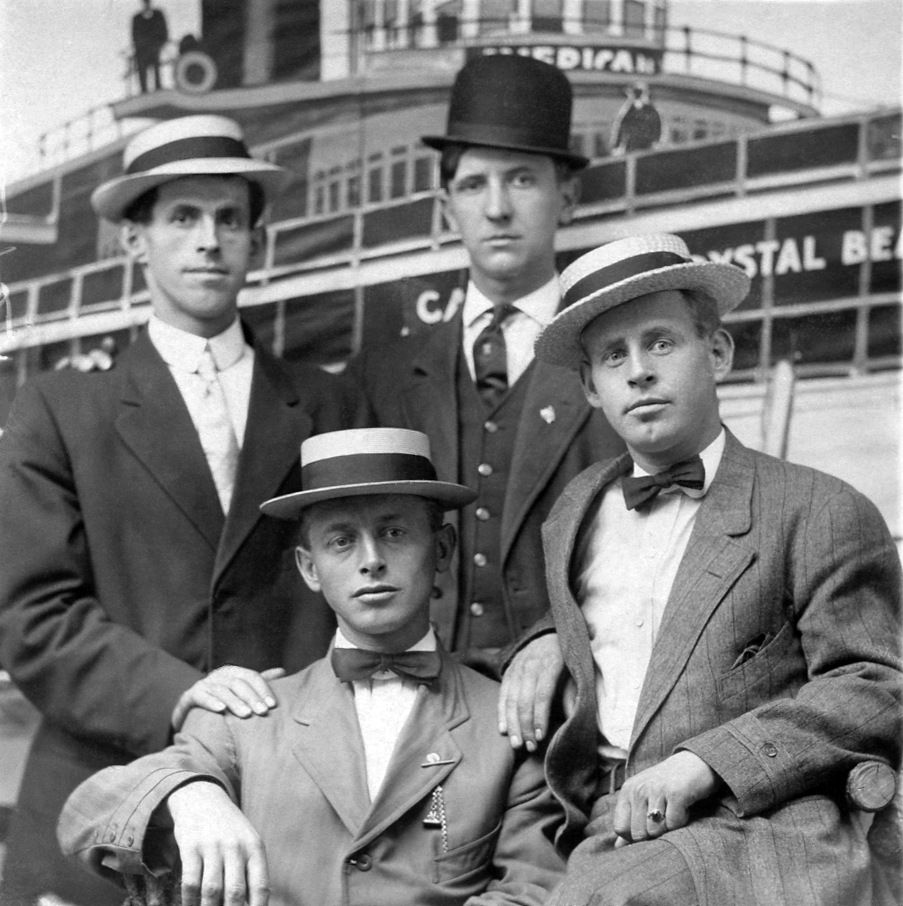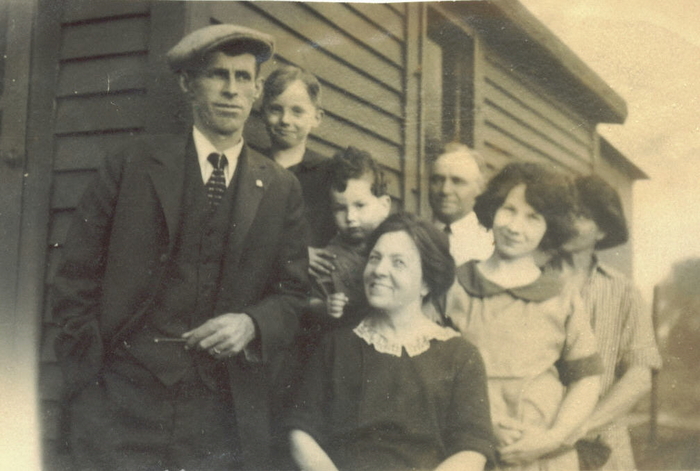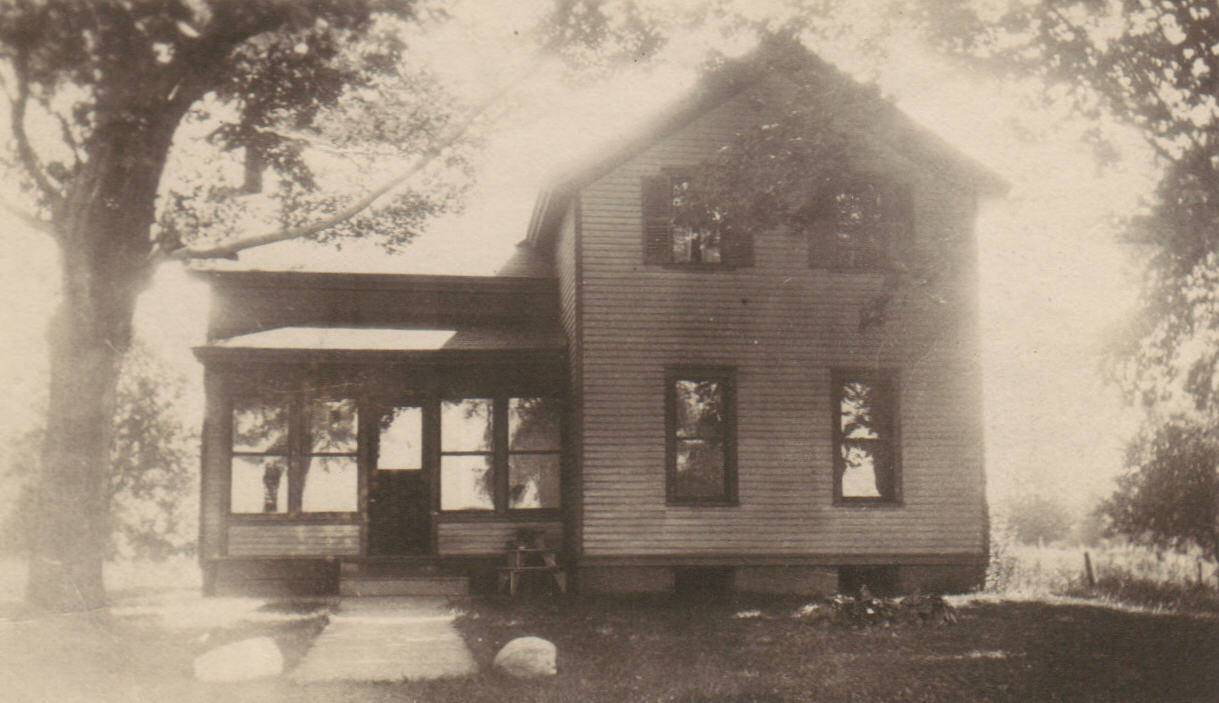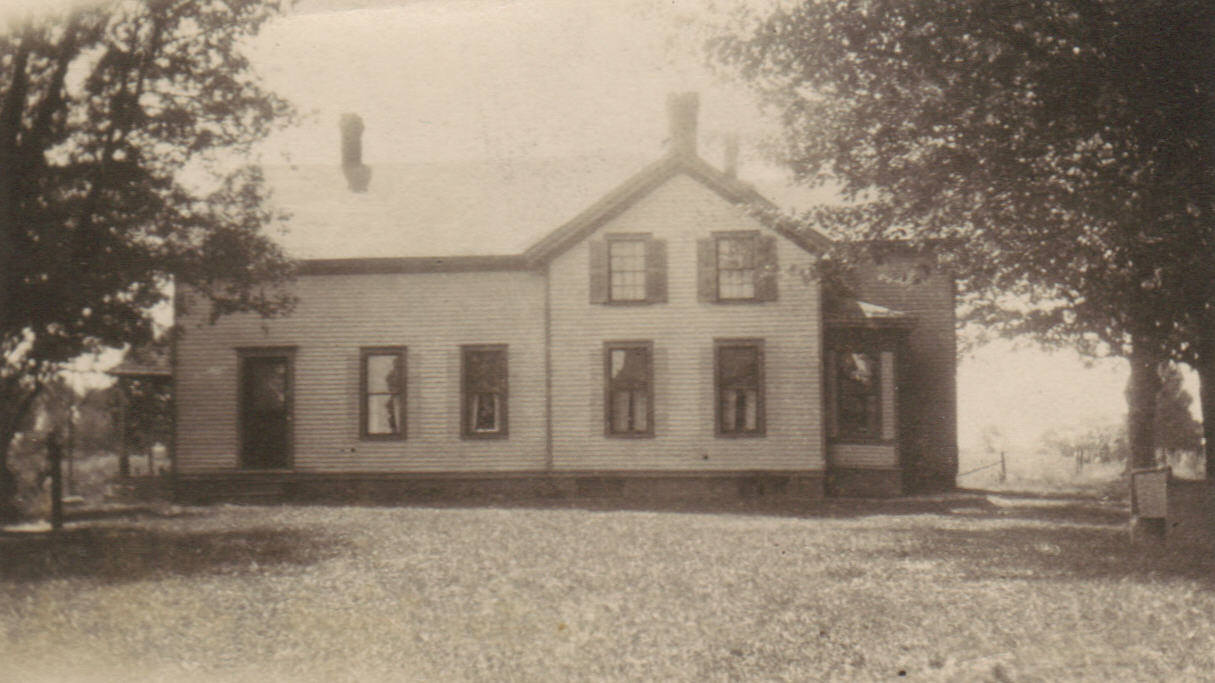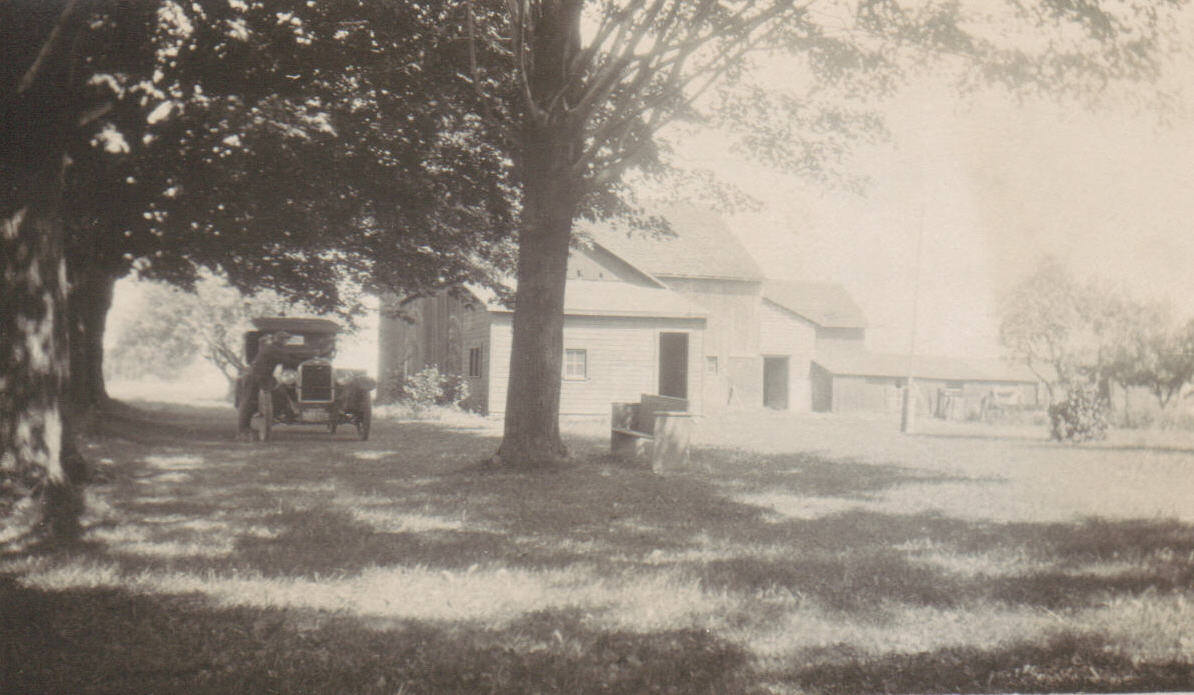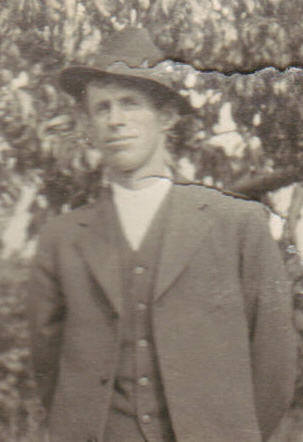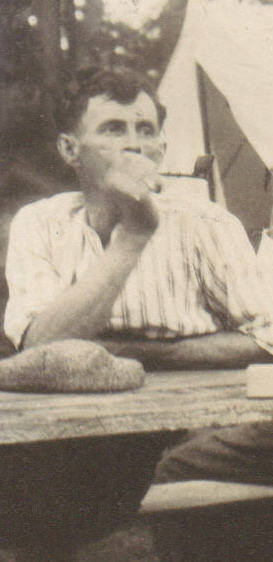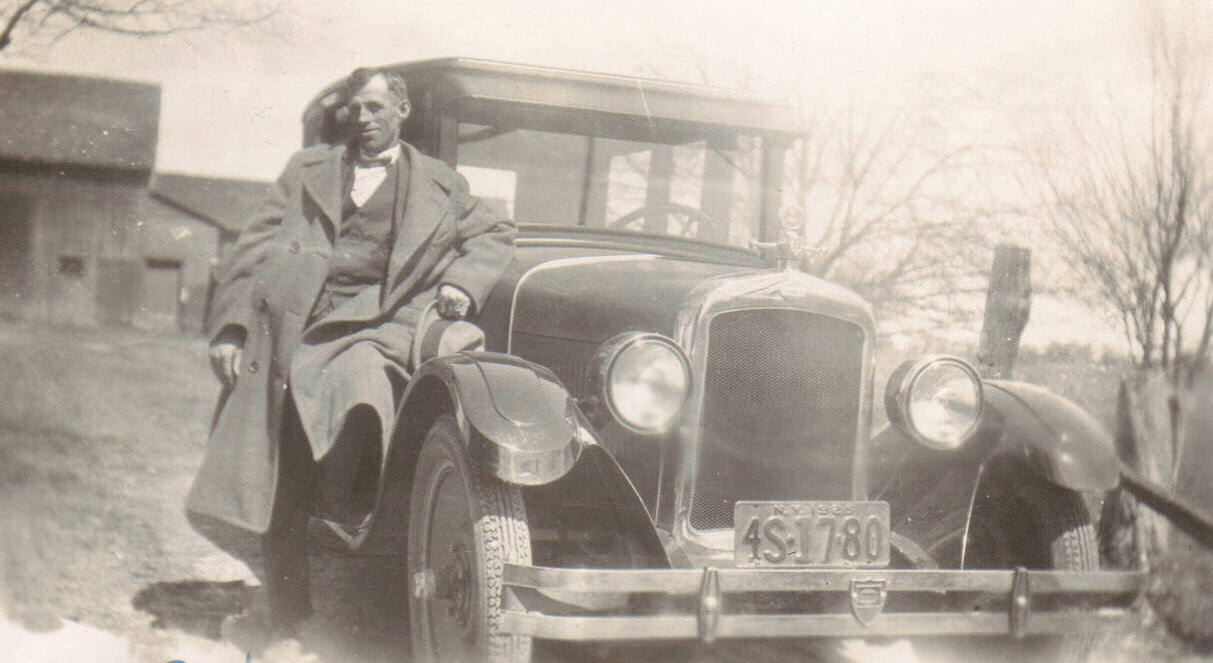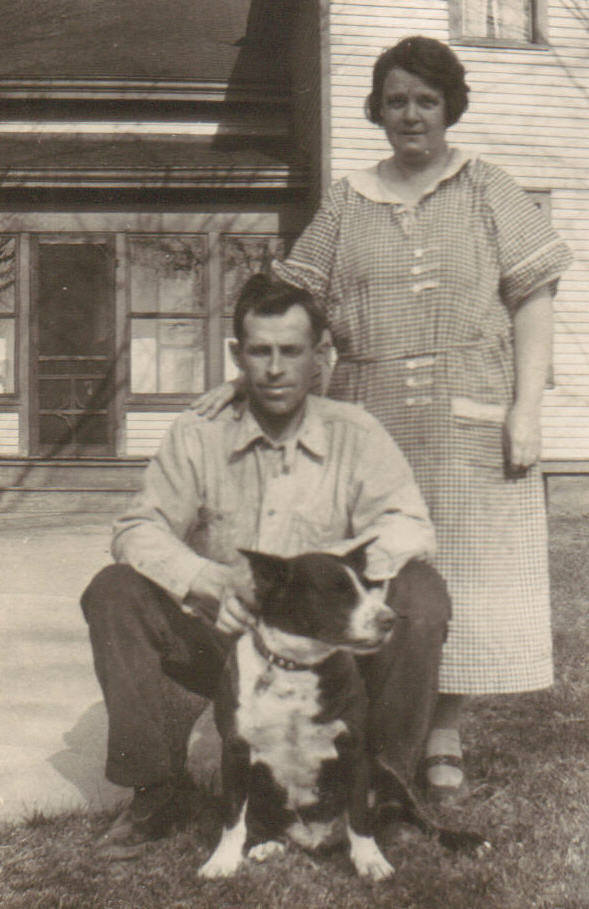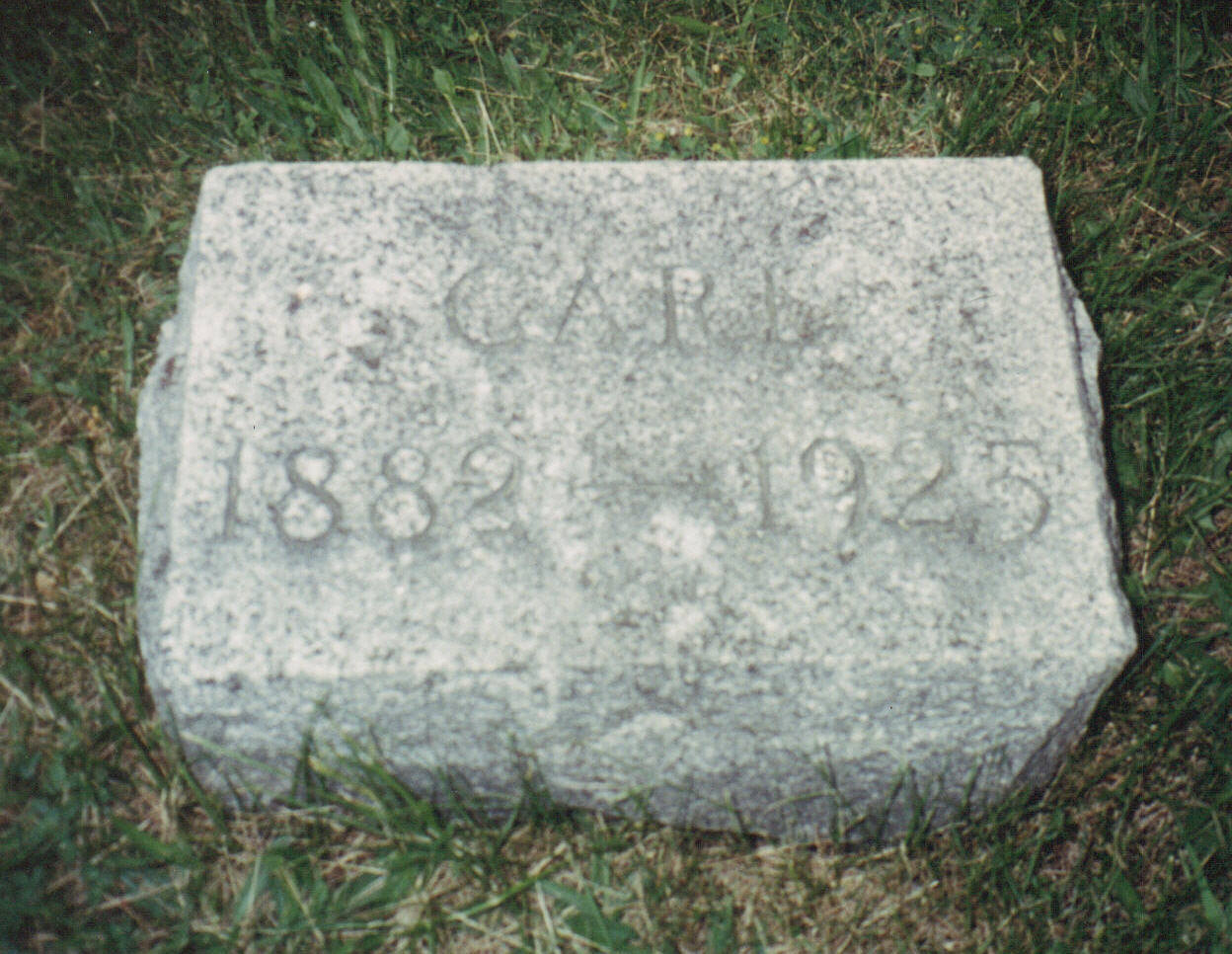The family lived on Putnam Street in southwestern Syracuse for about 12 years. (It was 16 and/or 14-1/2 Putnam before the address numbers changed in 1888; after that it was 221 Putnam). Karl's two younger brothers were born there: Otto (1884) and Alfred (1886). Karl attained his U.S. citizenship at the age of six on 25 September 1888 when his father became a naturalized U.S. citizen.
The family at first attended big St. Peter's German Lutheran Church, but later joined the closer and smaller St. Paul's German Lutheran Church at the corner of Oswego and Shonnard Streets. Karl was confirmed there at the age of 13 years, in a class of 22 children, by Pastor Georg Merschroth on 29 March 1896. According to his military pension records, he also attended the local public school(s) of Syracuse for four years.
Karl's mother's two younger brothers, Jacob Gilcher (a northside Syracuse barber) and Carl/Charles Gilcher (a shoemaker) also settled in Syracuse. Other relatives in the area included more distantly related Gilchers, Kreischers, Kohls, Ludwigs, Grubs and others from the same section of Germany. Karl's father was a member of the Syracuse Saengerbund (German singing society) and a deacon of St. Paul's Church (1890-1893), so there were many opportunities to socialize within the larger Syracuse German-speaking community, during the period when German-Americans made up about a quarter of Syracuse's population. Old photos indicate the boys and their father also participated on some organized sports teams.
Around 1895 the Kreischer family moved north about nine miles out of the city and settled on their 37-acre parcel of land in Lot 92 of Cicero Township, situated just to the east of the village of North Syracuse, in the location then known as Taft Settlement (today, their land would lie along the east side of Church Street Extension, generally between Hamilton and Taft Roads). Their old farmhouse was located where today Kreischer Road meets Church Street. The Kreischers raised corn, tobacco, potatoes, tomatoes, peas, beans, carrots, squash, eggs, and fruit (apples, cherries, plums, grapes, and strawberries) and sold their produce at the farmers' market on Syracuse's north side. The 1900 census, taken on 21 June, shows Carl [spelled with a C] living there with his family, age 17, a farm laborer.
On 4 August 1900 his father accompanied Karl to the U.S. Army recruitment office in Syracuse and gave his signed permission for Karl to enlist (also falsely implying that Karl was already 18 years old, as they supplied the Army with a false birthdate of 15 June 1882). It is not known why Karl wanted to enlist, but it was noted in the record that he preferred service with the Ninth Infantry in China (where the Boxer Rebellion had been raging since June). Perhaps his religious convictions led him to volunteer to help rescue the Christian missionaries in China--or perhaps Karl, raised as a Syracuse city boy, did not care for the farming life his parents had chosen. An unsigned note tucked in the Kreischer family German Bible that begins, "The bad bad Boy He was to inlist--Karl Kreischer" suggests that someone, perhaps his mother, did not approve of his decision.
His description upon enlistment was: Weight 121-1/2 lbs., Height 5 feet 6 inches, complexion dark; color of eyes brown, color of hair brown; occupation farmer. Always a slender man, he would later grow to be 5'10" tall, weigh around 140 pounds, and be remarkable for his piercing dark eyes, inherited from his mother.
Two days after enlisting Karl was inducted as a Private in Company E of the Ninth Infantry of the U.S. Army and was immediately sent to San Francisco on the transport ship "Warren" (arriving 16 August), then on to Nagasaki, Japan (arriving 6 September 1900). He took the transport "Sumner" from Nagasaki to Taku, China (8-12 Sept.), then moved to Pekin (Beijing), China (12-22 Sept.), arriving after the rebellion had been quelled by multinational forces. While stationed in Pekin he contracted acute malaria and spent time in the Regimental Hospital there. He remained in Pekin until 2 May 1901, when he returned to Taku (22-24 May) and then was sent to Manila on the transport "Indiana," arriving 2 June 1901 to fight against "the Philippine Insurrection," the armed guerrilla rebellion of natives against the U.S. annexation of the country following the Spanish-American War.
On 13 June 1901 Karl's company was sent to Samar Island, arriving at Tarangnan, Samar two days later. Following the notorious Balangiga massacre which took place on Samar in late September, Karl's Company E was involved in an engagement at Camp Gandara on 16 October 1901 (12 U.S. soldiers killed, 8 wounded); an engagement on 11 November 1901 (1 killed), another on 7 December; and an engagement at Dapdap on 24 December 1901 (7 killed, 5 wounded), when Capt. Francis Shoeffel led 18 men of Company E in hand-to-hand jungle combat with a large force of insurgent "bolomen" who ambushed them.
Karl himself was involved in the October ambush and, according to a letter to his mother published in the Syracuse Evening Herald on December 23, 1901, it was "a pretty tight place," when 37 U.S. soldiers were attacked by over 300 insurgents with machetes and rifles. "As it was fight or die we put up a desperate struggle for about twenty minutes. We finally got together and the insurgents started to run."
In late January 1902 Karl was transferred to Taoiran, Samar, where he stayed until 7 April. He returned to the U.S. on a series of transport ships, through Nagasaki, arriving in San Francisco on the transport "Hancock" on 27 June, and then returned to regimental headquarters at Madison Barracks near Sackets Harbor and Watertown, New York (3 July 1902). He remained at Madison Barracks for almost a year, then finished up his three-year hitch at Plattsburg (NY) Barracks, where he was discharged 5 August 1903, having had enough of military life.
Karl returned to Syracuse, lived at 1017 Lodi Street, and worked as a fireman (the man who shovels coal into the steam engine) for the West Shore Rail Road. He soon married Elleanor Mary ("Nellie") Roberts of Watertown, NY (on 18 January 1904, Rev. Frederick W. Fuess officiating in Watertown); they were both 21 years old. Their first child, Alfred (named after Karl's youngest brother) was born in Syracuse in 1905; their second, Clara, was born the following year in Watertown, where the family had relocated. Around that time Karl began having stomach problems, chills, and frequent headaches, thought to be after-effects of his bout with malaria during the service.
By 1907 the family lived at 10 West Mullin Street in Watertown and Karl was working at the Watertown railroad yards, for either the New York Central Railroad or the Rome, Watertown & Ogdensburg Railroad, making between $90-$120 per month. In 1909 they were living at Taylor Flats, 550 Coffeen Street (Coffeen & Engine Streets), near the railroad yards, south of the Black River. In early 1910 Karl was working for the (New York Central?) railroad in Buffalo, NY and by March the family had moved there, joining him to live at 586 Swan Street. Their youngest child, Charles Robert ("Bob") was born in Buffalo in August 1911. Karl was a loving and affectionate father who treated his children with humor, kindness, warmth, and understanding. He called his little daughter "Sis," and she felt she was the apple of his eye.
Around this time Karl, along with others, began adopting the more Americanized spelling of his Christian name: Carl.
By 1914 Carl Kreischer had returned to North Syracuse to live with his family on the Kreischer farm. This move was probably due to his father's declining health, and the expectation that the oldest son in a German family would take over the family farm. Carl moved his young family into the old farmhouse where he had once lived as a youth, while his parents lived in the newer home up the street that his father had built. Following in his parents' footsteps, Carl became a member of the Taft Settlement Grange (the local chapter of a national farmers' educational and social society) on 2 May 1914. He would be a loyal and active participant, serving the community on various committees and elected to a succession of offices (from Janitor to Gate Keeper to Steward to Overseer to Trustee), until his death.
After his father died in 1915, Carl took over management of the Kreischer farm. Hired hands and even Carl and Nellie's small children helped do their part to take care of the crops and animals and make the farm productive. It was a hard but rewarding country life. And Carl and Nellie were not so busy with the farm that they could not take time away to visit her extended family in Watertown or go with groups of friends to enjoy picnics, auto touring, fishing and camping trips up north, at Oneida Lake, Moon Lake, or in the Adirondack Mountains.
According to the Grange minute books, in 1921 Carl helped oversee the plans and the building of an addition to the Grange Hall. On 4 February 1922, "Mr. Kreischer also gave a report he did not favor the consolidation of schools as he did not think the tax would be any less and it would not be of benefit to the rural schools." On 15 April 1922 a Grange meeting was held at the home of "Karl" Kreischer with 41 members present. But that spring he felt so ill that he initiated an application (under the name Carl Kreischer) for a U.S. military pension on the basis of being partially disabled and unable to make a living due to having contracted malaria while in the Army in China.
The next year, on 6 January 1923, the Grange minute book documented the completion of its building project: "Report of Building Committee by Bro. Kreischer total cost of Hall 2173.68; Furnace 236.83; total $2,410.53. Committee given rising vote of thanks." Not long after that, on 27 March 1923 Carl Kreischer underwent surgery and it was discovered that he had cancer of the large intestine. His physician, Dr. C. E. McElwain, performed three more operations in attempting to remove all the "growths" and certified in support of Carl's application for a pension increase in July that Carl was now totally unable to work. Carl remained in the hospital until the day after Decoration Day (end of May).
The neighbors of the Grange Hall responded: On 7 April 1923: "Bill from Sister Hessler for Flowers $1.00 for Bro Carl Kreischer"; on 21 April 1923, "New Business: Bro Smith and Bro Albert Purdy apointed committee to visit Bro Kreischer when he is able to have visitors"; on 19 May 1923: "Bro Smith reported that Bro Kreischer was much improved and expects to soon be with us again"; on 2 June 1923: "New Business: Motion made and carried we have an entertainment or something of the kind the next meeting in honor of Bro Kreischer being back with us to decide later what we will have--decided to have Ice cream Cake & sandwiches."
Carl's mother, in failing health, had moved downtown to live with Carl's brother, Otto, and his wife; they would take care of her until her death in November 1923. Carl inherited the Kreischer farm upon her death. As Carl recuperated over the next several months, he took on the project of finding and overseeing the installation of an acetelene lighting plant for the Grange Hall. He donated a pig to be raffled off at a Grange-sponsored oyster supper in December ("a rising vote of thanks given Bro Kreischer for donating the Pig") and also donated a cook stove (perhaps his mother's) "if the Grangers would get it."
On 7 March 1925 "Brother Kreischer gave an explanation on insurance on automobiles" to the 38 members present at the Grange meeting. That year he purchased a new Oakland sedan touring car, the first brand-new, four-door automobile in the neighborhood. As his daughter would later recall, had her father lived, the family might have been well off. The house was paid for and the farm boasted a newly-built tobacco shed, a huge barn, a team of horses, a full complement of cows, pigs, chickens, ducks, and geese; they'd had profitable harvests, and owned state-of-the-art farm machinery. Nellie Kreischer even had a new sealskin fur coat.
But on 25 June 1925 Carl fell ill again, and stayed in bed for six months. Grange members were delegated to visit "Brother Kreischer," by then too sick with cancer to attend the meetings. On 17 October the committee reported "Brother Kreischer comfortable as could be expected." Members sent him a "postcard shower" in early November, and in early December planned to send him a "Sunshine Box."
On Tuesday night, 22 December 1925 between 10:30 and 11:00 p.m., after nine days without eating any food, Carl Kreischer died at home of colon cancer. He was a mere 43 years old, and left behind a widow and three children ages 20, 19, and 14. He was buried two days later, on Christmas Eve, beside the graves of his parents in North Syracuse Cemetery.
The members of the Taft Settlement Grange draped their charter in black for 15 days in honor of the passing of Brother Carl Kreischer. In 1927 Nellie donated a large picture to the Grange in Carl's memory.
Without Carl's interest, expertise, and guidance, the Kreischer farm did not survive the Great Depression years intact, but was slowly subdivided into smaller parcels and gradually sold off to support his wife and children. But much, much longer than the farm lasted, the memories of Carl Kreischer among those who loved him, or learned of him, remained green.
[CLICK on each photo to read caption and view full-size.]
The family lived on Putnam Street in southwestern Syracuse for about 12 years. (It was 16 and/or 14-1/2 Putnam before the address numbers changed in 1888; after that it was 221 Putnam). Karl's two younger brothers were born there: Otto (1884) and Alfred (1886). Karl attained his U.S. citizenship at the age of six on 25 September 1888 when his father became a naturalized U.S. citizen.
The family at first attended big St. Peter's German Lutheran Church, but later joined the closer and smaller St. Paul's German Lutheran Church at the corner of Oswego and Shonnard Streets. Karl was confirmed there at the age of 13 years, in a class of 22 children, by Pastor Georg Merschroth on 29 March 1896. According to his military pension records, he also attended the local public school(s) of Syracuse for four years.
Karl's mother's two younger brothers, Jacob Gilcher (a northside Syracuse barber) and Carl/Charles Gilcher (a shoemaker) also settled in Syracuse. Other relatives in the area included more distantly related Gilchers, Kreischers, Kohls, Ludwigs, Grubs and others from the same section of Germany. Karl's father was a member of the Syracuse Saengerbund (German singing society) and a deacon of St. Paul's Church (1890-1893), so there were many opportunities to socialize within the larger Syracuse German-speaking community, during the period when German-Americans made up about a quarter of Syracuse's population. Old photos indicate the boys and their father also participated on some organized sports teams.
Around 1895 the Kreischer family moved north about nine miles out of the city and settled on their 37-acre parcel of land in Lot 92 of Cicero Township, situated just to the east of the village of North Syracuse, in the location then known as Taft Settlement (today, their land would lie along the east side of Church Street Extension, generally between Hamilton and Taft Roads). Their old farmhouse was located where today Kreischer Road meets Church Street. The Kreischers raised corn, tobacco, potatoes, tomatoes, peas, beans, carrots, squash, eggs, and fruit (apples, cherries, plums, grapes, and strawberries) and sold their produce at the farmers' market on Syracuse's north side. The 1900 census, taken on 21 June, shows Carl [spelled with a C] living there with his family, age 17, a farm laborer.
On 4 August 1900 his father accompanied Karl to the U.S. Army recruitment office in Syracuse and gave his signed permission for Karl to enlist (also falsely implying that Karl was already 18 years old, as they supplied the Army with a false birthdate of 15 June 1882). It is not known why Karl wanted to enlist, but it was noted in the record that he preferred service with the Ninth Infantry in China (where the Boxer Rebellion had been raging since June). Perhaps his religious convictions led him to volunteer to help rescue the Christian missionaries in China--or perhaps Karl, raised as a Syracuse city boy, did not care for the farming life his parents had chosen. An unsigned note tucked in the Kreischer family German Bible that begins, "The bad bad Boy He was to inlist--Karl Kreischer" suggests that someone, perhaps his mother, did not approve of his decision.
His description upon enlistment was: Weight 121-1/2 lbs., Height 5 feet 6 inches, complexion dark; color of eyes brown, color of hair brown; occupation farmer. Always a slender man, he would later grow to be 5'10" tall, weigh around 140 pounds, and be remarkable for his piercing dark eyes, inherited from his mother.
Two days after enlisting Karl was inducted as a Private in Company E of the Ninth Infantry of the U.S. Army and was immediately sent to San Francisco on the transport ship "Warren" (arriving 16 August), then on to Nagasaki, Japan (arriving 6 September 1900). He took the transport "Sumner" from Nagasaki to Taku, China (8-12 Sept.), then moved to Pekin (Beijing), China (12-22 Sept.), arriving after the rebellion had been quelled by multinational forces. While stationed in Pekin he contracted acute malaria and spent time in the Regimental Hospital there. He remained in Pekin until 2 May 1901, when he returned to Taku (22-24 May) and then was sent to Manila on the transport "Indiana," arriving 2 June 1901 to fight against "the Philippine Insurrection," the armed guerrilla rebellion of natives against the U.S. annexation of the country following the Spanish-American War.
On 13 June 1901 Karl's company was sent to Samar Island, arriving at Tarangnan, Samar two days later. Following the notorious Balangiga massacre which took place on Samar in late September, Karl's Company E was involved in an engagement at Camp Gandara on 16 October 1901 (12 U.S. soldiers killed, 8 wounded); an engagement on 11 November 1901 (1 killed), another on 7 December; and an engagement at Dapdap on 24 December 1901 (7 killed, 5 wounded), when Capt. Francis Shoeffel led 18 men of Company E in hand-to-hand jungle combat with a large force of insurgent "bolomen" who ambushed them.
Karl himself was involved in the October ambush and, according to a letter to his mother published in the Syracuse Evening Herald on December 23, 1901, it was "a pretty tight place," when 37 U.S. soldiers were attacked by over 300 insurgents with machetes and rifles. "As it was fight or die we put up a desperate struggle for about twenty minutes. We finally got together and the insurgents started to run."
In late January 1902 Karl was transferred to Taoiran, Samar, where he stayed until 7 April. He returned to the U.S. on a series of transport ships, through Nagasaki, arriving in San Francisco on the transport "Hancock" on 27 June, and then returned to regimental headquarters at Madison Barracks near Sackets Harbor and Watertown, New York (3 July 1902). He remained at Madison Barracks for almost a year, then finished up his three-year hitch at Plattsburg (NY) Barracks, where he was discharged 5 August 1903, having had enough of military life.
Karl returned to Syracuse, lived at 1017 Lodi Street, and worked as a fireman (the man who shovels coal into the steam engine) for the West Shore Rail Road. He soon married Elleanor Mary ("Nellie") Roberts of Watertown, NY (on 18 January 1904, Rev. Frederick W. Fuess officiating in Watertown); they were both 21 years old. Their first child, Alfred (named after Karl's youngest brother) was born in Syracuse in 1905; their second, Clara, was born the following year in Watertown, where the family had relocated. Around that time Karl began having stomach problems, chills, and frequent headaches, thought to be after-effects of his bout with malaria during the service.
By 1907 the family lived at 10 West Mullin Street in Watertown and Karl was working at the Watertown railroad yards, for either the New York Central Railroad or the Rome, Watertown & Ogdensburg Railroad, making between $90-$120 per month. In 1909 they were living at Taylor Flats, 550 Coffeen Street (Coffeen & Engine Streets), near the railroad yards, south of the Black River. In early 1910 Karl was working for the (New York Central?) railroad in Buffalo, NY and by March the family had moved there, joining him to live at 586 Swan Street. Their youngest child, Charles Robert ("Bob") was born in Buffalo in August 1911. Karl was a loving and affectionate father who treated his children with humor, kindness, warmth, and understanding. He called his little daughter "Sis," and she felt she was the apple of his eye.
Around this time Karl, along with others, began adopting the more Americanized spelling of his Christian name: Carl.
By 1914 Carl Kreischer had returned to North Syracuse to live with his family on the Kreischer farm. This move was probably due to his father's declining health, and the expectation that the oldest son in a German family would take over the family farm. Carl moved his young family into the old farmhouse where he had once lived as a youth, while his parents lived in the newer home up the street that his father had built. Following in his parents' footsteps, Carl became a member of the Taft Settlement Grange (the local chapter of a national farmers' educational and social society) on 2 May 1914. He would be a loyal and active participant, serving the community on various committees and elected to a succession of offices (from Janitor to Gate Keeper to Steward to Overseer to Trustee), until his death.
After his father died in 1915, Carl took over management of the Kreischer farm. Hired hands and even Carl and Nellie's small children helped do their part to take care of the crops and animals and make the farm productive. It was a hard but rewarding country life. And Carl and Nellie were not so busy with the farm that they could not take time away to visit her extended family in Watertown or go with groups of friends to enjoy picnics, auto touring, fishing and camping trips up north, at Oneida Lake, Moon Lake, or in the Adirondack Mountains.
According to the Grange minute books, in 1921 Carl helped oversee the plans and the building of an addition to the Grange Hall. On 4 February 1922, "Mr. Kreischer also gave a report he did not favor the consolidation of schools as he did not think the tax would be any less and it would not be of benefit to the rural schools." On 15 April 1922 a Grange meeting was held at the home of "Karl" Kreischer with 41 members present. But that spring he felt so ill that he initiated an application (under the name Carl Kreischer) for a U.S. military pension on the basis of being partially disabled and unable to make a living due to having contracted malaria while in the Army in China.
The next year, on 6 January 1923, the Grange minute book documented the completion of its building project: "Report of Building Committee by Bro. Kreischer total cost of Hall 2173.68; Furnace 236.83; total $2,410.53. Committee given rising vote of thanks." Not long after that, on 27 March 1923 Carl Kreischer underwent surgery and it was discovered that he had cancer of the large intestine. His physician, Dr. C. E. McElwain, performed three more operations in attempting to remove all the "growths" and certified in support of Carl's application for a pension increase in July that Carl was now totally unable to work. Carl remained in the hospital until the day after Decoration Day (end of May).
The neighbors of the Grange Hall responded: On 7 April 1923: "Bill from Sister Hessler for Flowers $1.00 for Bro Carl Kreischer"; on 21 April 1923, "New Business: Bro Smith and Bro Albert Purdy apointed committee to visit Bro Kreischer when he is able to have visitors"; on 19 May 1923: "Bro Smith reported that Bro Kreischer was much improved and expects to soon be with us again"; on 2 June 1923: "New Business: Motion made and carried we have an entertainment or something of the kind the next meeting in honor of Bro Kreischer being back with us to decide later what we will have--decided to have Ice cream Cake & sandwiches."
Carl's mother, in failing health, had moved downtown to live with Carl's brother, Otto, and his wife; they would take care of her until her death in November 1923. Carl inherited the Kreischer farm upon her death. As Carl recuperated over the next several months, he took on the project of finding and overseeing the installation of an acetelene lighting plant for the Grange Hall. He donated a pig to be raffled off at a Grange-sponsored oyster supper in December ("a rising vote of thanks given Bro Kreischer for donating the Pig") and also donated a cook stove (perhaps his mother's) "if the Grangers would get it."
On 7 March 1925 "Brother Kreischer gave an explanation on insurance on automobiles" to the 38 members present at the Grange meeting. That year he purchased a new Oakland sedan touring car, the first brand-new, four-door automobile in the neighborhood. As his daughter would later recall, had her father lived, the family might have been well off. The house was paid for and the farm boasted a newly-built tobacco shed, a huge barn, a team of horses, a full complement of cows, pigs, chickens, ducks, and geese; they'd had profitable harvests, and owned state-of-the-art farm machinery. Nellie Kreischer even had a new sealskin fur coat.
But on 25 June 1925 Carl fell ill again, and stayed in bed for six months. Grange members were delegated to visit "Brother Kreischer," by then too sick with cancer to attend the meetings. On 17 October the committee reported "Brother Kreischer comfortable as could be expected." Members sent him a "postcard shower" in early November, and in early December planned to send him a "Sunshine Box."
On Tuesday night, 22 December 1925 between 10:30 and 11:00 p.m., after nine days without eating any food, Carl Kreischer died at home of colon cancer. He was a mere 43 years old, and left behind a widow and three children ages 20, 19, and 14. He was buried two days later, on Christmas Eve, beside the graves of his parents in North Syracuse Cemetery.
The members of the Taft Settlement Grange draped their charter in black for 15 days in honor of the passing of Brother Carl Kreischer. In 1927 Nellie donated a large picture to the Grange in Carl's memory.
Without Carl's interest, expertise, and guidance, the Kreischer farm did not survive the Great Depression years intact, but was slowly subdivided into smaller parcels and gradually sold off to support his wife and children. But much, much longer than the farm lasted, the memories of Carl Kreischer among those who loved him, or learned of him, remained green.
[CLICK on each photo to read caption and view full-size.]
Inscription
Carl
1882-1925
Gravesite Details
Carl is buried in Grave 3, of the family plot, but his gravemarker is on Grave 4 (per cemetery info, 2000)
